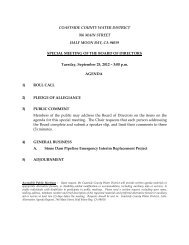Lower Pilarcitos Creek Groundwater Basin Study - Coastside ...
Lower Pilarcitos Creek Groundwater Basin Study - Coastside ...
Lower Pilarcitos Creek Groundwater Basin Study - Coastside ...
You also want an ePaper? Increase the reach of your titles
YUMPU automatically turns print PDFs into web optimized ePapers that Google loves.
slopes. In addition, the <strong>Pilarcitos</strong> <strong>Creek</strong> and Mills <strong>Creek</strong> alluvial valleys are characterized<br />
by the Tunitas-Lockwood soil association.<br />
The <strong>Lower</strong> <strong>Pilarcitos</strong> <strong>Creek</strong> groundwater basin includes the Tierra-Colma soils on<br />
high marine terraces, Watsonville-Elkhorn soils on low marine terraces, and Tunitas-<br />
Lockwood soils on floodplains along lower <strong>Pilarcitos</strong> <strong>Creek</strong> and Arroyo Leon. Specific<br />
soil types with significant areal extent across the groundwater basin include the Botella<br />
clay loam, Denison clay loam and loam, Farallone loam, Soquel loam, Tierra loam, and<br />
Watsonville clay loam and loam.<br />
An important characteristic of soils for the local water balance is the soil<br />
moisture holding capacity, or the maximum amount of water that is stored in a soil and<br />
available to plants for evapotranspiration. Soil moisture holding capacity is estimated for<br />
each vertical soil zone and expressed in terms of inch/inch. For this study, the entire<br />
thickness and soil moisture holding capacity of each soil was assumed to be available to<br />
plants. Soils in the area are relatively thick, ranging from 48 inches (Farallone loam) to<br />
67 inches (Denison loam). Soil moisture holding capacities range from 2.94 inches<br />
(Tierra loam) to 10.80 inches (Botella clay loam); these were averaged according to the<br />
relative areal extent of the soils across the basin, resulting in an average soil moisture<br />
holding capacity of 6.70 inches.<br />
Streamflow<br />
Streamflow for <strong>Pilarcitos</strong> <strong>Creek</strong> has been recorded by the United States<br />
Geological Survey (USGS) at two gauges in the study area (see Figure 1). In addition,<br />
one gauge exists in the upper portions of Purisima <strong>Creek</strong> located south of and adjacent<br />
to the <strong>Pilarcitos</strong> <strong>Creek</strong> watershed. Because the Purisima <strong>Creek</strong> station is located in a<br />
relatively undisturbed watershed, surface water flow characteristics, ET, and<br />
groundwater recharge estimates from the Purisima <strong>Creek</strong> watershed help confirm<br />
watershed characteristics of the upper <strong>Pilarcitos</strong> <strong>Creek</strong> watershed.<br />
A summary of streamflow records for the creeks are shown in Table 3a. <strong>Pilarcitos</strong><br />
<strong>Creek</strong> at Half Moon Bay has been measured since 1966, while <strong>Pilarcitos</strong> <strong>Creek</strong> below<br />
Stone Dam and Purisima <strong>Creek</strong> near Half Moon Bay have been measured for relatively<br />
short intervals of time. Note that the <strong>Pilarcitos</strong> <strong>Creek</strong> below Stone Dam and Purisima<br />
<strong>Creek</strong> stations have similar watershed basin areas. In addition, the two stations are<br />
similar in terms of hydrogeologic controls; both are situated below relatively undeveloped<br />
watersheds in narrow, bedrock-exposed canyons that provide for little opportunity for<br />
10



